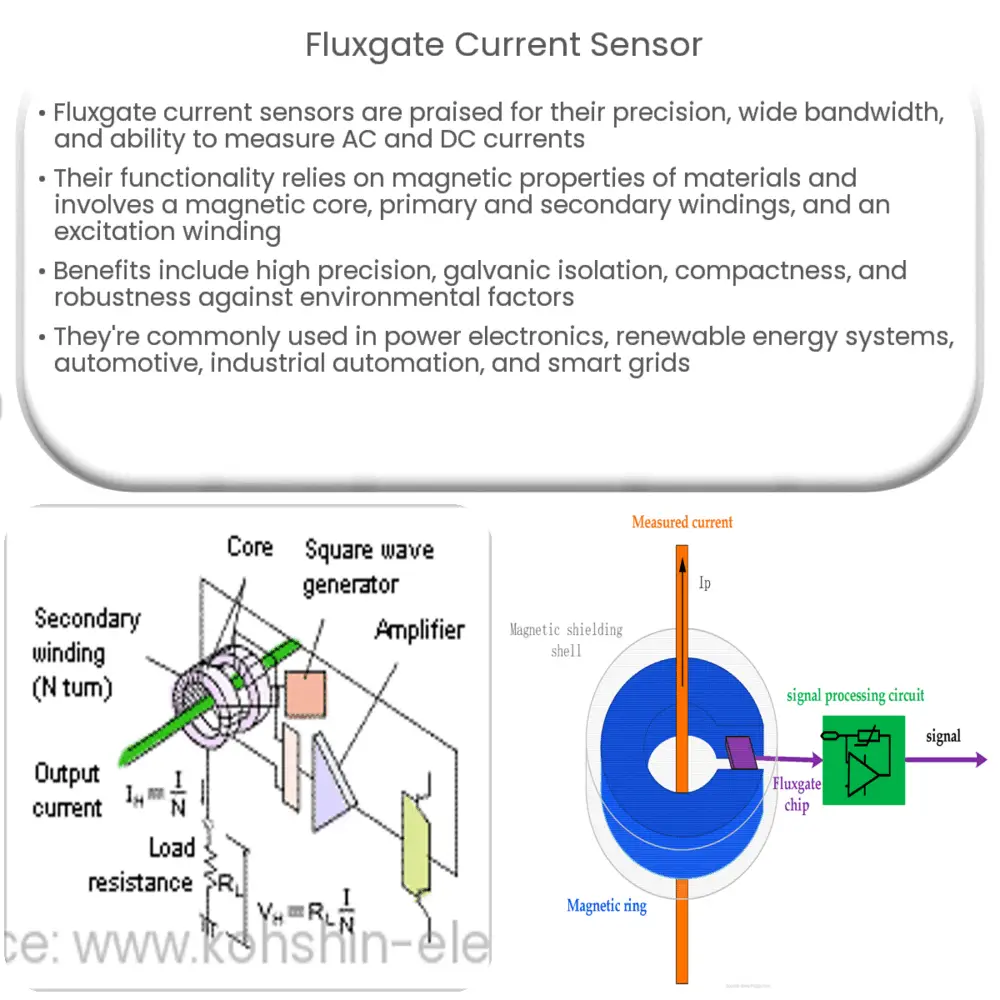Fluxgate current sensors offer high precision, wide bandwidth, and galvanic isolation for accurate current measurements in various applications.

Fluxgate Current Sensor: A Comprehensive Overview
Introduction
Fluxgate current sensors are a type of magnetic sensor used for measuring current in a wide range of applications. They are known for their high precision, wide bandwidth, and ability to measure both AC and DC currents. This article provides an overview of the fundamental principles, advantages, and typical applications of fluxgate current sensors.
Operating Principle
The principle behind fluxgate current sensors relies on the magnetic properties of certain materials, specifically their saturation behavior when subjected to a magnetic field. In a fluxgate sensor, a magnetic core is used as the primary sensing element. This core is typically made of a high-permeability, low-hysteresis material, such as amorphous metal or nanocrystalline alloy.
A primary winding is wrapped around the core, through which the current to be measured is passed. This creates a magnetic field in the core, which in turn induces a voltage in a secondary winding. The secondary winding is connected to an electronic circuit, which is responsible for detecting the induced voltage and converting it into a current measurement.
A key aspect of the fluxgate current sensor is the excitation winding, which is also wound around the core. This winding is driven by an alternating current, which generates a time-vary
ing magnetic field in the core. The excitation frequency is chosen so that it is much higher than the frequency of the current to be measured. This allows the sensor to distinguish between the signal generated by the excitation and the signal generated by the current under measurement.
When the magnetic field generated by the primary winding reaches a certain level, the core becomes saturated. At this point, the voltage induced in the secondary winding changes significantly, providing a clear indication of the current passing through the primary winding. By analyzing the secondary winding voltage, the electronic circuit can accurately determine the magnitude and direction of the measured current.
Advantages of Fluxgate Current Sensors
Fluxgate current sensors offer several advantages over other current sensing technologies:
- High precision: These sensors can provide highly accurate current measurements due to their low noise and low drift characteristics.
- Wide bandwidth: They can measure both AC and DC currents, with a frequency range extending from DC up to several megahertz, depending on the sensor design.
- Galvanic isolation: The absence of a direct electrical connection between the primary and secondary windings ensures excellent galvanic isolation, reducing the risk of electrical interference and increasing safety.
- Compact size: Fluxgate current sensors can be designed with a small footprint, making them suitable for applications with limited space.
- Robustness: These sensors exhibit a high degree of immunity to external magnetic fields, temperature variations, and other environmental factors.
Typical Applications
Fluxgate current sensors are used in a wide range of applications across various industries. Some common use cases include:
- Power electronics: They are used in inverters, converters, and motor drives for current monitoring and control.
- Renewable energy systems: Fluxgate current sensors are employed in solar and wind power systems for accurate current measurement and management.
- Automotive: In electric and hybrid vehicles, these sensors are used for battery management systems, motor control, and charging systems.
- Industrial automation: Fluxgate current sensors are utilized for process control, robotics, and automation applications, where precise current measurements are essential.
- Smart grid and energy management: They are used in various energy management systems, such as power quality monitoring, fault detection, and load management.
In conclusion, fluxgate current sensors are an advanced and versatile technology that offers numerous advantages over traditional current sensing techniques. Their precision, wide bandwidth, and robustness make them a popular choice for a diverse array of applications.

